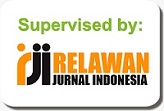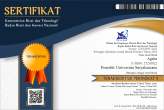PENDAPATAN PERTANIAN SEBAGAI DETERMINAN PERTUMBUHAN EKONOMI DI ASIA SELATAN
Abstract
Analisis makroekonomi salah satunya meliputi analisis pertumbuhan ekonomi secara empiris. Katalis pertumbuhan ekonomi yang sebenarnya perlu diketahui untuk merumuskan kebijakan yang komprehensif dan efektif untuk pembangunan berkelanjutan. Penelitian ini bertujuan untuk mengetahui pengaruh pendapatan pertanian terhadap pertumbuhan ekonomi di kawasan Asia Selatan. Penelitian ini merupakan penelitian kuantitatif. Data dalam penelitian ini diambil dari laman World Bank, yaitu data pendapatan pertanian dan produk domestik bruto sebagai proksi pertumbuhan ekonomi. Penelitian ini menggunakan periode tahun 1960-2019. Hasil penelitian menunjukkan bahwa pendapatan pertanian bepengaruh positif signifikan terhadap pertumbuhan ekonomi.
Keywords
Full Text:
PDF (Bahasa Indonesia)References
Abubaker, R. (2015). The asymmetric impact of trade openness on output volatility. Empirical Economics, 49(3), 881–887. https://doi.org/10.1007/s00181-014-0899-2
Ahmed, A., & Suardi, S. (2009). Do Financial and Trade Liberalisation Cause Macroeconomic Volatility in Sub-Saharan Africa? World Development, 37(10), 1623–1636.
Akobeng, E. (2017). Safety net for agriculture: Effect of idiosyncratic income shock on remittance payments. International Journal of Social Economics, 44(1), 2–20. https://doi.org/10.1108/IJSE-12-2014-0271
Ali, Q., Raza, A., Narjis, S., Saeed, S., & Khan, M. T. I. (2020). Potential of renewable energy, agriculture, and financial sector for the economic growth: Evidence from politically free, partly free and not free countries. Renewable Energy, 162, 934–947. https://doi.org/10.1016/j.renene.2020.08.055
Aziz, N., Sharif, A., Raza, A., & Rong, K. (2020). Revisiting the role of forestry, agriculture, and renewable energy in testing environment Kuznets curve in Pakistan: evidence from Quantile ARDL approach. Environmental Science and Pollution Research, 27(9), 10115–10128. https://doi.org/10.1007/s11356-020-07798-1
Bajpai, N. (2018). Business Research Methods. 362. http://www.amazon.com/Business-Research-Methods-2nd-Edition/dp/1741032539
Bjørnskov, C. (2016). Economic freedom and economic crises. European Journal of Political Economy. https://doi.org/10.1080/00987913.1991.10763986
Ćorić, B., & Pugh, G. (2013). Foreign direct investment and output growth volatility: A worldwide analysis. International Review of Economics and Finance, 25, 260–271. https://doi.org/10.1016/j.iref.2012.07.011
Croes, R., & Ridderstaat, J. (2017). The effects of business cycles on tourism demand flows in small island destinations. Tourism Economics, 23(7), 1451–1475. https://doi.org/10.1177/1354816617697837
Croes, R., Ridderstaat, J., & Rivera, M. (2018). Asymmetric Business Cycle Effects and Tourism Demand Cycles. Journal of Travel Research, 57(4), 419–436. https://doi.org/10.1177/0047287517704086
Doucouliagos, C., & Ulubasoglu, M. A. (2006). Economic freedom and economic growth: Does specification make a difference? European Journal of Political Economy, 22(1), 60–81. https://doi.org/10.1016/j.ejpoleco.2005.06.003
Gu, X., Wu, J., Guo, H., & Li, G. (2018). Local tourism cycle and external business cycle. Annals of Tourism Research. https://doi.org/10.1016/0160-7383(74)90016-4
Hakura, D. S. (2009). Output volatility in emerging market and developing countries: What explains the “Great Moderation†of 1970-2003? Finance a Uver - Czech Journal of Economics and Finance, 59(3), 229–254.
Hoffman, J. P. (2021). Linear Regression Model Applications in R. CRC Press.
Justesen, M. K. (2008). The effect of economic freedom on growth revisited: New evidence on causality from a panel of countries 1970-1999. European Journal of Political Economy, 24(3), 642–660. https://doi.org/10.1016/j.ejpoleco.2008.06.003
Komatsu, H., Ambel, A. A., Koolwal, G., & Yonis, M. B. (2022). Gender norms, landholdership, and rural land use fee and agricultural income tax in Ethiopia. Land Use Policy, 121(July). https://doi.org/10.1016/j.landusepol.2022.106305
Kose, M. A., Prasad, E. S., & Terrones, M. E. (2003). Financial Integration and Macroeconomic Volatility. IMF Working Papers, 03(50), 1. https://doi.org/10.5089/9781451846997.001
Krieger, T., & Meierrieks, D. (2016). Political capitalism: The interaction between income inequality, economic freedom and democracy. European Journal of Political Economy, 45, 115–132. https://doi.org/10.1016/j.ejpoleco.2016.10.005
Li, W. W., Ma, X. L., & Yu, H. (2019). Is the domestic tourism cycle synchronized with the economic cycle? Evidence from Mainland China and Taiwan. Asia Pacific Journal of Tourism Research, 24(9), 944–964. https://doi.org/10.1080/10941665.2019.1653332
Ma, W., & Abdulai, A. (2019). IPM adoption, cooperative membership and farm economic performance: Insight from apple farmers in China. China Agricultural Economic Review, 11(2), 218–236. https://doi.org/10.1108/CAER-12-2017-0251
Mayers, S.-A., & Jackman, M. (2011). Investigating the business cycle properties of tourist flows to Barbados. Munich Personal RePEc Archive, 38646.
McArthur, J. W., & McCord, G. C. (2017). Fertilizing growth: Agricultural inputs and their effects in economic development. Journal of Development Economics, 127, 133–152. https://doi.org/10.1016/j.jdeveco.2017.02.007
Mobarak, A. M. (2005). Democracy, volatility, and economic development. Review of Economics and Statistics, 87(2), 348–361. https://doi.org/10.1162/0034653053970302
Mohey-Ud-Din, G., & Siddiqui, M. W. (2016). Determinants of GDP fluctuations in selected south asian countries: A macro-panel study. Pakistan Development Review, 55(4), 483–497. https://doi.org/10.30541/v55i4i-iipp.483-497
Narayan, S., & Narayan, P. K. (2013). The inflation-output nexus: Empirical evidence from India, South Africa, and Brazil. Research in International Business and Finance, 28(1), 19–34. https://doi.org/10.1016/j.ribaf.2012.09.003
Ojeda Luna, T., Zhunusova, E., Günter, S., & Dieter, M. (2020). Measuring forest and agricultural income in the Ecuadorian lowland rainforest frontiers: Do deforestation and conservation strategies matter? Forest Policy and Economics, 111(September 2019). https://doi.org/10.1016/j.forpol.2019.102034
Panda, S. (2015). Farmer education and household agricultural income in rural India. International Journal of Social Economics, 42(6), 514–529. https://doi.org/10.1108/IJSE-12-2013-0278
Rougier, E. (2014). Output Volatility and Fdi To Middle East and North African Countries: a Close-Up on the Source Countries. Region et Developpement, 40(July), 139–165.
Salvati, L., & Carlucci, M. (2013). The impact of mediterranean land degradation on agricultural income: A short-term scenario. Land Use Policy, 32(2013), 302–308. https://doi.org/10.1016/j.landusepol.2012.11.007
Spiliopoulos, L. (2010). The determinants of macroeconomic volatility : A Bayesian model averaging approach. Munich Personal RePEc Archive, 26832.
Tang, C. F., & Abosedra, S. (2014). The impacts of tourism, energy consumption and political instability on economic growth in the MENA countries. Energy Policy, 68(2013), 458–464. https://doi.org/10.1016/j.enpol.2014.01.004
Torres, M., Howitt, R., & Rodrigues, L. (2019). Analyzing rainfall effects on agricultural income: Why timing matters. EconomiA, 20(1), 1–14. https://doi.org/10.1016/j.econ.2019.03.006
Wong, K. K. F. (1997). The relevance of business cycles in forecasting international tourist arrivals. Tourism Management, 18(8), 581–586. https://doi.org/10.1016/S0261-5177(97)00073-3
DOI: https://doi.org/10.35194/agri.v4i2.2700
Refbacks
- There are currently no refbacks.

This work is licensed under a Creative Commons Attribution 4.0 International License.
AGRITA (AGri) INDEXED BY :
Fakultas Sains Terapan Universitas Suryakancana, Jl. Pasir Gede Raya-Cianjur, 43216, Email: agrita@unsur.ac.id

This work is licensed under a Creative Commons Attribution 4.0 International License.








